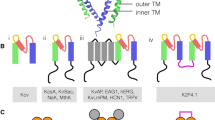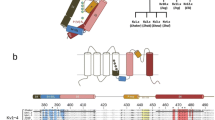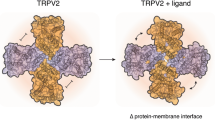Abstract
Theorems are rarely used in biology because they rarely help the descriptive experimentation to which biologists are devoted. A generalization of Kirchoff’s current law—the Shockley-Ramo (SR) theorem [1–6]—seems an exception. SR allows interpretation of macroscopic scale ‘gating’ currents associated with atomic scale charge movements within proteins.
Similar content being viewed by others
References
Yoder, P.D., et al.: Optimized terminal current calculation for Monte Carlo device simulation. IEEE Trans. Comp.-Aided Design Integr. Circuits Syst. 16, 1082–1087 (1997)
Yoder, P.D., Gärtner, K., Fichtner, W.: A generalized Ramo-Shockley theorem for classical to quantum transport at arbitrary frequencies. J. Appl. Phys. 79, 1951–1954 (1996)
Shockley, W.: Currents to conductors induced by a moving point charge. J. Appl. Phys. 9, 635–636 (1938)
Ramo, S.: Currents induced by electron motion. Proc. IRE. 27, 584–585 (1939)
Pellegrini, B.: Electric charge motion, induced current, energy balance, and noise. Phys. Rev. B 34, 5921–5924 (1986)
Kim, H., et al.: An extended proof of the Ramo-Shockley theorem. Solid-State Elect. 34, 1251–1253 (1991)
Bottinger, E., Furshpan, E.: Recording flight movements in insects. Science 116, 60–61 (1952)
Almers, W.: Gating currents and charge movements in excitable membranes. Rev. Physiol. Biochem. Pharmacol. 82, 96–190 (1978)
Armstrong, C.M.: Ionic pores, gates, and gating currents. Quart. Rev. Biophys. 7, 179–210 (1975)
Armstrong, C.M.: Sodium channels and gating currents. Physiol. Rev. 61, 644–683 (1981)
Bezanilla, F.: Gating of sodium and potassium channels. J. Membr. Biol. 88(2), 97–111 (1985)
Bezanilla, F.: The voltage sensor in voltage-dependent ion channels. Physiol. Rev. 80(2), 555–592 (2000)
Bezanilla, F., Armstrong, C.M.: A low-cost signal averager and data-acquisition device. Am. J. Physiol. 232(5), C211–C215 (1977)
Chanda, B., et al.: Gating charge displacement in voltage-gated ion channels involves limited transmembrane movement. Nature 436(7052), 852–856 (2005)
Hille, B.: Ionic Channels of Excitable Membranes. 3rd ed. pp. 1–814. Sinauer Associates Inc, Sunderland (2001)
Nonner, W.: Effects of Leiurus scorpion venom on the “gating’ current in myelinated nerve. Adv. Cytopharmacol. 3, 345–352 (1979)
Roux, M.J., et al.: Fast inactivation in Shaker K+ channels. Properties of ionic and gating currents. J. Gen. Physiol. 111(5), 625–638 (1998)
Seoh, S.A., et al.: Voltage-sensing residues in the S2 and S4 segments of the Shaker K+ channel. Neuron 16(6), 1159–1167 (1996)
Sigworth, F.: Voltage gating of ion channels. Quart. Rev. Biophys. 27, 1–40 (1994)
Hodgkin, A.L., Huxley, A.F.: A quantitative description of membrane current and its application to conduction and excitation in nerve. J. Physiol. 117, 500–544 (1952)
Schneider, M., Chandler, W.K.: Voltage-dependent charge movement in skeletal muscle: a possible step in excitation-contraction coupling. Nature (London) 242, 244–246 (1973)
Bezanilla, F., Armstrong, C.M.: Inactivation of the sodium channel. I. Sodium current experiments. J. Gen. Physiol. 70(5), 549–566 (1977)
Bezanilla, F., Rojas, E., Taylor, R.E.: Sodium and potassium conductance changes during a membrane action potential. J. Physiol. (London) 211, 729–751 (1970)
Bezanilla, F., Rojas, E., Taylor, R.E.: Time course of the sodium influx in squid giant axon during a single voltage clamp pulse. J. Physiol. 207(1), 151–164 (1970)
Weiss, T.F.: Cellular Biophysics, vol. 1 and 2, p. 552. MIT Press, Cambridge MA USA (1996)
Hodgkin, A.L.: Chance and Design, p. 401. Cambridge University Press, New York (1992)
Cole, K.S.: Four lectures on biophysics. Institute of Biophysics, University of Brazil, Rio De Janeiro (1947)
Huxley, A.: Kenneth Stewart Cole. Biograph. Mem. Roy. Soc. 38, 99–110 (1992)
Hodgkin, A., Huxley, A., Katz, B.: Ionic currents underlying activity in the giant axon of the squid. Arch. Sci. Physiol. 3, 129–150 (1949)
Neher, E., Sakmann, B.: Single channel currents recorded from the membrane of denervated muscle fibers. Nature 260, 799–802 (1976)
Neher, E., Sakmann, B., Steinbach, J.H.: The extracellular patch clamp: a method for resolving currents through individual open channels in biological membranes. Pflügers. Arch. 375, 219–228 (1978)
Sakmann, B., Neher, E.: Single Channel Recording, 2nd ed, p. 700. Plenum New York (1995)
Miller, C. (ed.): Ion Channel Reconstitution. Plenum, New York (1986)
Rudy, B., Iverson, L.E., (eds.): Ion Channels Methods in Enzymology. vol. 207, p. 917. Academic, New York (1992)
Bezanilla, F.: Single sodium channels from the squid giant axon. Biophys. J. 52(6), 1087–1090 (1987)
Roux, B.: Influence of the membrane potential on the free energy of an intrinsic protein. Biophys. J. 73(12), 2980–2989 (1997)
Nonner, W., et al.: Relating microscopic charge movement to macroscopic currents: the Ramo-Shockley theorem applied to ion channels. Biophys. J. 87(6), 3716–3722 (2004)
Aboud, S., et al.: A poisson P3M force field scheme for particle-based simulations of ionic liquids. J. Comput. Elect. 3, 117–133 (2004)
Aksimentiev, A., Schulten, K.: Imaging alpha-hemolysin with molecular dynamics: ionic conductance, osmotic permeability, and the electrostatic potential map. Biophys. J. 88(6), 3745–3761 (2005)
Saraniti, M., Aboud, S., Eisenberg, R.: The simulation of ionic charge transport in biological ion channels: an introduction to numerical methods. Rev. Comp. Chem. 22, 229–294 (2005)
van der Straaten, T.A., et al.: BioMOCA—a Boltzmann transport Monte Carlo model for ion channel simulation. Mole. Simul. 31, 151–171 (2004)
Author information
Authors and Affiliations
Corresponding author
Rights and permissions
About this article
Cite this article
Eisenberg, B., Nonner, W. Shockley-Ramo theorem measures conformation changes of ion channels and proteins. J Comput Electron 6, 363–365 (2007). https://doi.org/10.1007/s10825-006-0130-6
Published:
Issue Date:
DOI: https://doi.org/10.1007/s10825-006-0130-6




